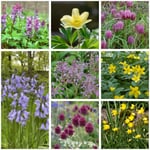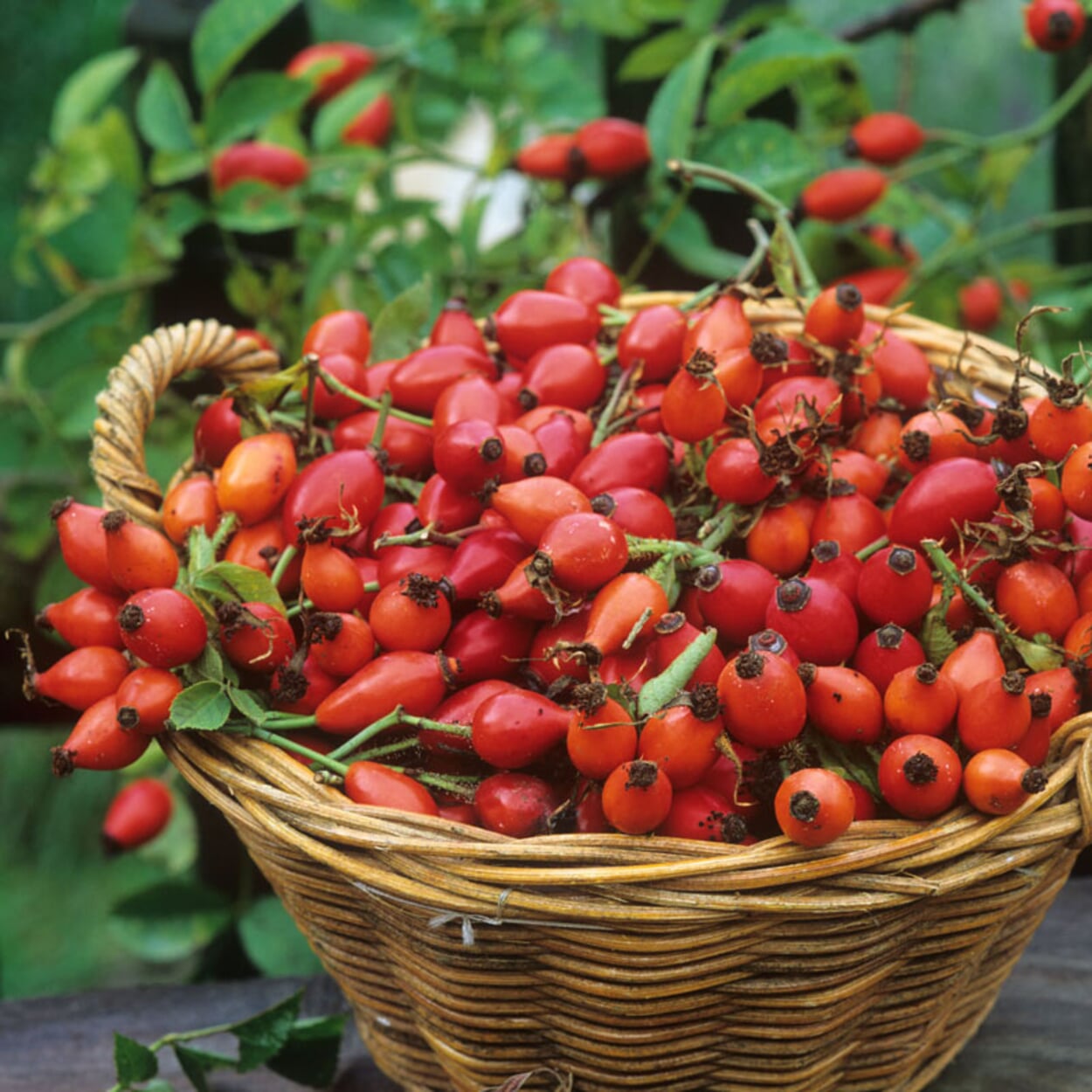Native flower bulbs

Native flower bulbs
- Ensuring species diversity with native flower bulbs
- For almost all garden locations
General Information
The package contains:
Fingered Corydalis 5 pieces (Corydalis solida) This pretty spring-flowering plant is a native member of the poppy family, which can be found wild in beech, oak and riparian forests, in bushes, vineyards and orchards. This species is much rarer than the similar-looking hollow larkspur and is classified as "endangered" in some federal states. The nectar-rich, purple and distinctly fragrant flowers make the plant an excellent bee pasture in March and April; they also provide food for citron butterflies, while the leaves feed the caterpillars of the black apollo butterfly. In the right location, the larkspur reproduces abundantly in the garden. With a height of 10-20 cm and grey-green, feathery foliage, it is also a beautiful addition to rock gardens, for example. grading 5/+
Leipzig anemone 3 pieces (Anemone × lipsiensis) This natural hybrid of Anemone nemorosa and Anemone ranunculoides is a less common, extremely richly flowering native herald of spring. The plant was first discovered near Leipzig. In addition to the unusual creamy yellow flower color, the rather dark, deeply lobed leaves are also remarkable. This rare anemone needs some time to develop, but is then vigorous and long-lived. It grows to a height of 10-20 cm and feeds numerous species of wild bees and other insects during the flowering period in March and April. Grading Size I
Checkerboardflower 10 pieces (Fritillaria meleagris) This lily plant, also known as lapwing, is one of the most unusual native plants with its "checkered" flowers. The checkerboard flower is rarely found in the wild - it is classified as endangered - but then usually in larger stands in damp locations, for example the occasionally flooded meadows of the Saale, Main, Danube and Neckar rivers. From April to May, one or two nodding flowers form at the end of the up to 30 cm high shoots. The rather large tulip-like bells in light pink to dark purple, rarely also in white, show the typical checkerboard pattern that makes this plant so special. The flowers provide food for various species of wild bees. The plant spreads in the garden via breeding bulbs and seeds. Grading 7/+
Atlantic bluebell 10 pieces (Hyacinthoides non-scripta) The bluebell is a typical inhabitant of deciduous woodland and, in the right location, covers the ground with a bright blue carpet that shines from afar during the flowering season. The plant also spreads readily in the garden; as it tolerates root pressure, it is well suited to colonizing difficult places under large trees. In April and May, the 20 cm high, loose flower panicles provide food mainly for bumblebees. Grading 7/+
Beautiful Kiellauch5 pieces (Allium carinatum subsp. pulchellum) This species occurs wild in dry to moist nutrient-poor meadows in southern and central Europe. Beautiful Kiellauch is therefore ideal for rock gardens, as well as for steppe-like plantings and sunny, dry wild herbaceous borders. With a height of around 40 cm, it provides a wild structure and blooms in midsummer with very unusual flowers: the purple, bell-like single flowers emerge like small fountains from the umbel, which is also ideal for cutting. In suitable locations, this ornamental leek will gather a lot; this can be easily regulated by cutting it back early after flowering. It feeds various wild bees, including the bumblebee. Grading Size I
Yellow anemone5 pieces (Anemone ranunculoides) The yellow anemone occurs rather rarely, but then in larger stands in the alluvial forests and moist mixed deciduous forests of Central and Eastern Europe. The delicate plant reproduces well with creeping rhizomes and seeds and, in the right location, forms large, approximately 20 cm high carpets, which are covered with bright yellow flowers in April and May. The plant feeds up to 18 different species of wild bee, as well as hoverflies and butterfly caterpillars. It is an ideal undergrowth for woody plants, but is also suitable for beds and borders. Grading Size I
Alliumsphaerocephalon This native ornamental leek is rarely found in its natural habitat and is therefore classified as endangered on the Red List. It can still be found sporadically on sunny dry grasslands, in bushes and vineyards, especially in the south of Germany as far as Hesse, Thuringia and Anhalt; further north it has almost disappeared. From June to August, it forms small, pointed inflorescences in pink to dark reddish-brown on 60-80 cm tall stems, which are visited by wild bees. It is ideal for use in natural plantings, but is also suitable for containers and as a cut flower. If the fruiting stems are left standing, the plant spreads well in the garden. Grading 7/+
Vineyard tulip 10 pieces (Tulipa sylvestris) This wild tulip is a so-called archaeophyte. These are plants that were already widespread in Central Europe before 1492, the year America was discovered. They are therefore not indigenous but, unlike neophytes, are considered native. The vineyard tulip is the only species of tulip found in the wild in Germany. Formerly widespread, it is now highly endangered and is protected as an endangered Red List species. The bright yellow, slightly nodding flowers appear from April (and throughout May) and exude a honey-like fragrance. They open in a star shape in the sun and are a good source of food for numerous wild bee species. The blue-green foliage provides a beautiful contrast to the flowers; the plant can grow up to 40 cm tall. Grading 6/+
Product Information
Article Number 213550
- Ensuring species diversity with native flower bulbs
- For almost all garden locations
The naturally occurring species of our local flora are referred to as native wild plants - these can be trees and shrubs or herbaceous plants such as perennials, annual and biennial flowers or the diverse group of bulbous plants. Some are widespread, while others are almost non-existent and are endangered species on the Red List. In principle, however, these plants have adapted to our environmental conditions for thousands of years and are therefore often easier to care for, more robust, more vigorous and more frugal than cultivated species or plants introduced from other areas of origin. They are also generally of high ecological value, as they provide food for a diverse animal world or, in extreme cases, ensure the survival of some highly specialized native insects that can only survive in association with certain plant species. But it is also important to ensure the preservation of these valuable plants themselves, as many species can hardly be found in their natural habitats due to over-fertilized soils, falling groundwater levels or large-scale sealing. Offering them a place in the garden is therefore an important contribution to preserving the diversity of native flora.
Our selection offers plants for almost all garden locations: from sunny to shady and from dry to damp.
Have a question?
If you have a question concerning this product you are welcome to contact us. For this your E-Mail program will open.
Customer Service
Ob Beratung, Ersatzteile oder Sonderwünsche - all Ihre Fragen und Anliegen behandelt unser Customer Service persönlich und fundiert.
Sie erreichen uns von Montag bis Freitag unter der Nummer +49 2309 939095 oder jederzeit unter info@manufactum.de
Das Gartenjahr
Egal ob großer Garten oder kleiner Balkon – Antworten auf alle Fragen der Gartenarbeit finden Sie im Manufactum Gartenjahr. Nach Gartentyp und Jahreslauf gegliedert werden alle wichtigen Arbeiten leicht verständlich und Schritt für Schritt beschrieben.
Zum Gartenjahr


